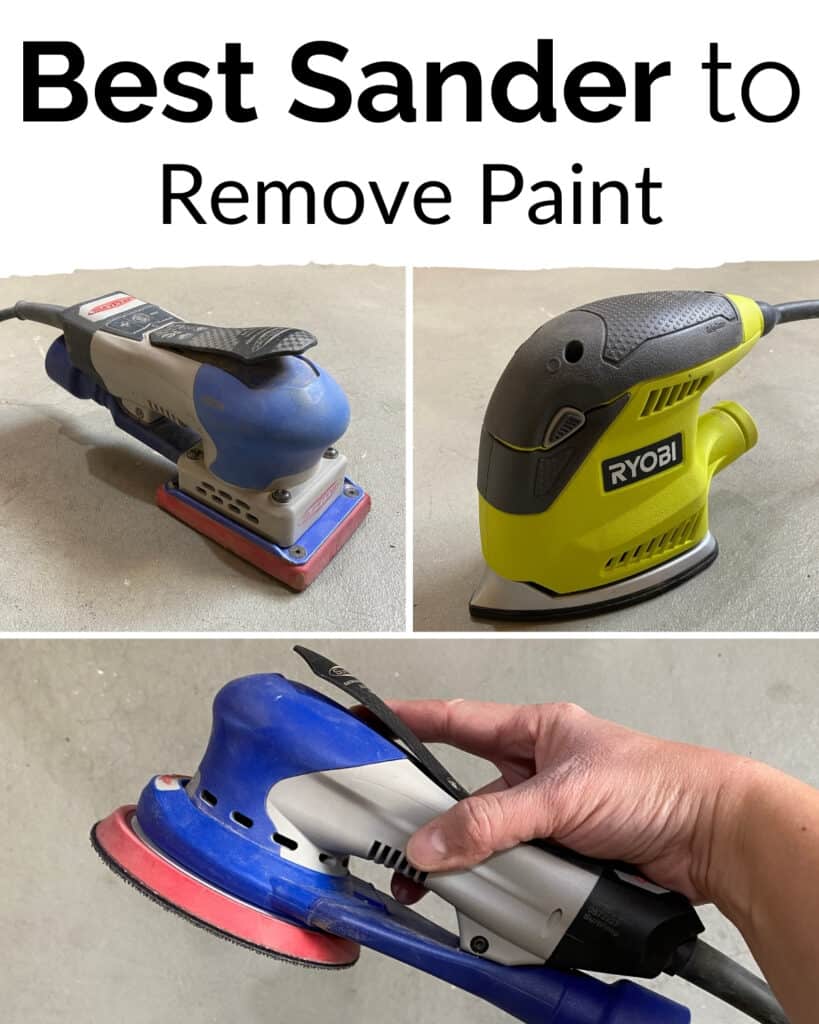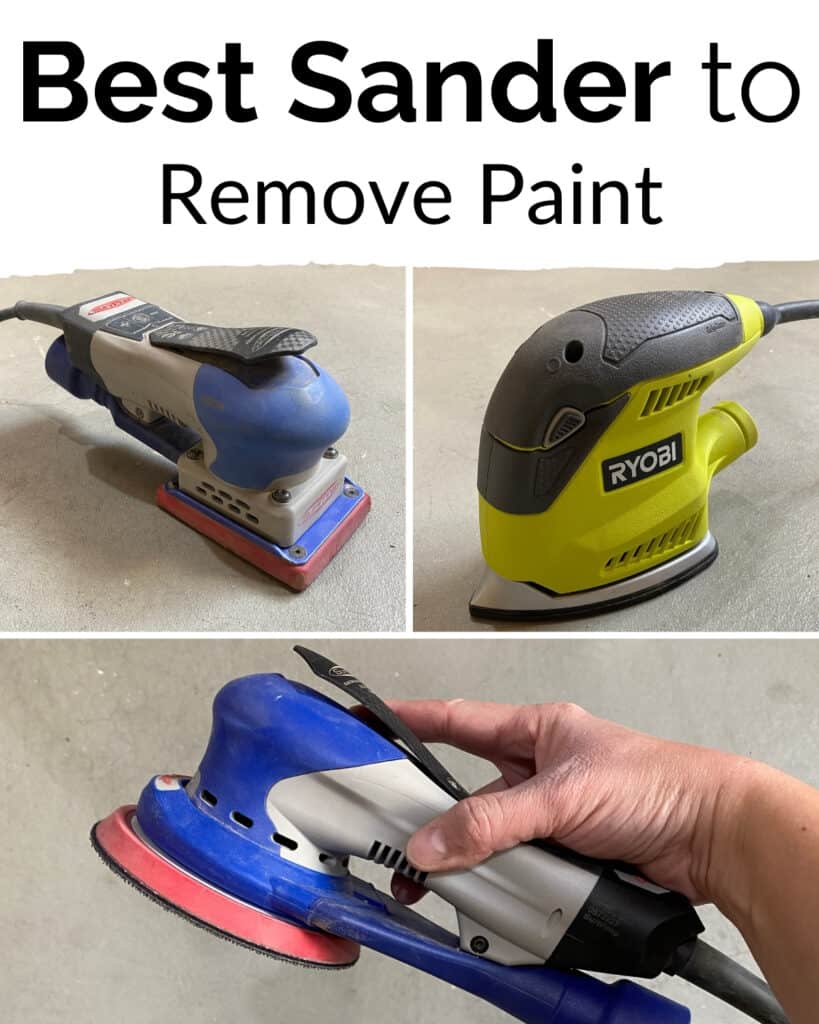Ahoy there, curious minds! Today we’re diving into the realm of home improvement to answer a burning question: can a palm sander remove paint? If you’ve ever looked at a worn-out wall, yearning to give it a fresh new look, you’re in for a treat.
Now, picture this: you’re armed with a trusty palm sander, ready to tackle those layers of old paint. But before we get ahead of ourselves, let’s explore the power of this mighty tool and whether it can make your painting dreams a reality.
Get ready for a wild ride as we uncover the wonders and limitations of palm sanders in the battle against paint. So dust off that imagination and let’s get sanding!

Can a Palm Sander Remove Paint?
Paint removal is a common task when it comes to home renovation projects. One tool that is often considered for this job is a palm sander. But can a palm sander effectively remove paint? In this in-depth article, we will explore the capabilities of a palm sander when it comes to paint removal. We will discuss its effectiveness, the factors that may impact its performance, and provide tips for achieving the best results. So, if you’re wondering whether a palm sander is the right tool for your paint removal needs, keep reading to find out more.
How Does a Palm Sander Work?
A palm sander is a handheld power tool that utilizes a rotating sanding pad to smooth surfaces. It is commonly used for sanding wood, but its effectiveness in removing paint depends on various factors. The palm sander typically uses sandpaper with a fine grit, which allows it to gently abrade the surface.
Effects of Paint Thickness
The thickness of the paint layer plays a vital role in determining whether a palm sander can remove it effectively. If the paint layer is relatively thin, a palm sander can be a suitable tool for complete removal. However, if the paint layer is thick, a palm sander may not be powerful enough to strip away all the layers in one go. In such cases, it’s best to consider alternative methods like heat guns or chemical paint strippers.
Type of Paint
The type of paint used on the surface also affects the efficiency of a palm sander for paint removal. Latex or water-based paints are generally easier to remove compared to oil-based paints. Latex paints tend to be more flexible and can be sanded away smoothly. On the other hand, oil-based paints are harder and more resistant, making their removal more challenging. In such cases, it may require multiple passes with a palm sander or the use of stronger abrasives.
Surface Material
The material of the surface being worked on is another important factor to consider. Palm sanders work well on flat surfaces, such as walls, floors, or furniture. They are particularly effective on wood surfaces. However, when it comes to intricate or curved surfaces, such as moldings or carvings, a palm sander may not be the most appropriate tool. In such cases, manual methods like scrapers or sanding blocks may be more suitable.
Benefits of Using a Palm Sander for Paint Removal
While a palm sander may have certain limitations for paint removal, it also offers several advantages. Here are some benefits of using a palm sander for this task:
1. Time-saving: A palm sander can speed up the paint removal process, especially when dealing with relatively thin paint layers.
2. Smooth finish: Palm sanders are designed to provide a smooth and even finish, making them ideal for prepping surfaces for repainting.
3. Versatility: Aside from paint removal, palm sanders can also be used for a variety of other sanding tasks, making them a versatile tool to have in your toolkit.
Tips for Achieving the Best Results with a Palm Sander
To maximize the effectiveness of a palm sander for paint removal, here are some helpful tips:
1. Use the right sandpaper grit: Use a coarse grit sandpaper (80-100 grit) for initial paint removal and then switch to a finer grit (120-150 grit) for a smooth finish.
2. Work in sections: Divide the painted surface into smaller sections and work on one section at a time for better control and even sanding.
3. Maintain consistent pressure: Apply even pressure while sanding to avoid uneven results or damage to the underlying surface.
4. Use proper safety gear: Wear goggles, a dust mask, and ear protection to protect yourself from dust and noise generated during the sanding process.
Can a Palm Sander Remove Paint from Different Surfaces?
Now that we have discussed the effectiveness of a palm sander for paint removal, let’s explore how it performs on different types of surfaces.
Wood Surfaces
Palm sanders are highly effective on wood surfaces when it comes to paint removal. The gentle abrasion of the sandpaper helps to remove paint without damaging the wood underneath. It is important to sand in the direction of the grain for a smooth and even finish.
Metal Surfaces
While palm sanders can be used on metal surfaces, they may not be the best option for paint removal. Metal surfaces require more aggressive methods, such as chemical strippers or wire brushes, to effectively remove paint.
Plastic Surfaces
Using a palm sander on plastic surfaces is generally not recommended for paint removal. The abrasive action of the sander can easily damage the plastic. It is better to use alternative methods like paint removers specifically designed for plastic surfaces.
In conclusion, while a palm sander can be a useful tool for paint removal, its effectiveness depends on various factors such as paint thickness, type, and surface material. It may not be suitable for all situations, especially when dealing with thick or stubborn paint layers. However, when used appropriately on the right surfaces, a palm sander can provide efficient and time-saving paint removal. Just remember to follow the tips mentioned above for achieving the best results.
Key Takeaways: Can a Palm Sander Remove Paint?
- Yes, a palm sander can remove paint from surfaces.
- Palm sanders are effective in removing paint from wood, metal, and other materials.
- They work by sanding the surface, gradually removing layers of paint.
- Palm sanders can be used for small DIY projects or larger renovation jobs.
- It’s important to wear protective gear and follow safety precautions when using a palm sander.
Frequently Asked Questions
When it comes to home improvement projects, removing paint can be a daunting task. One tool that often comes to mind is a palm sander. Let’s explore some common questions about whether a palm sander can effectively remove paint.
1. How does a palm sander work in removing paint?
A palm sander is designed to smooth surfaces by sanding them with the help of abrasive sandpaper. While it can be used to remove paint, it might not be the most efficient option. The sandpaper on a palm sander is generally fine-grit and more suitable for preparing surfaces or removing light layers of paint rather than heavy coats.
When using a palm sander to remove paint, it is important to note that it might take more time and effort compared to other methods. However, if the paint layer is thin or you only need to remove small patches, a palm sander can be a useful tool to achieve your desired result.
2. Can a palm sander remove all types of paint?
A palm sander can remove different types of paint, including latex, oil-based, and acrylic. However, the effectiveness of paint removal depends on various factors, such as the thickness of the paint, the type of surface, and the coarseness of the sandpaper used on the palm sander.
In general, a palm sander might struggle with thick layers of paint or paint that has been applied with multiple coats. In such cases, it is recommended to use more aggressive methods, like a heat gun or chemical paint strippers, to facilitate the paint removal process before resorting to a palm sander.
3. How can I maximize the effectiveness of a palm sander in removing paint?
To maximize the effectiveness of a palm sander in removing paint, there are a few steps you can take. First, start by using a lower grit sandpaper, such as 80 or 100, to roughen the paint surface and create better adhesion for subsequent sanding.
Next, gradually increase the grit of the sandpaper as you continue sanding. This will help smoothen the surface and remove the remaining paint. Finally, be patient and take breaks as sanding for extended periods can strain your hand. Remember, the effectiveness of a palm sander in removing paint might vary depending on the specific project and conditions.
4. Are there any safety precautions I should take when using a palm sander to remove paint?
Yes, there are important safety precautions to keep in mind when using a palm sander to remove paint. Always wear protective gear, including safety glasses or goggles to protect your eyes from flying debris, a dust mask to prevent inhalation of dust particles, and gloves to protect your hands.
Additionally, it is crucial to create a well-ventilated workspace and to avoid sanding lead-based paints, as they can pose serious health risks. If you suspect the presence of lead-based paint, it is recommended to consult a professional for safe removal as it requires specialized techniques.
5. Can I use a palm sander on delicate surfaces?
While a palm sander can be effective in removing paint from certain surfaces, it may not be suitable for delicate or easily damaged materials such as thin wood veneer or fragile antique finishes. The aggressive sanding motion of a palm sander can potentially cause damage.
If you need to remove paint from delicate surfaces, it is recommended to use alternative methods like chemical paint strippers or gentle hand sanding with a fine-grit sandpaper. These approaches are less likely to damage the surface while still achieving effective paint removal.

Summary
Want to remove paint? Consider using a palm sander! It’s a machine that can make the job faster and easier. A palm sander with the right sandpaper can remove old paint from surfaces like wood or metal. Just be careful not to damage the material underneath!
Using a palm sander is not difficult. You simply attach sandpaper to the sander, switch it on, and move it across the painted surface. The sander’s vibrations help to strip away the paint. Remember to wear safety goggles and a mask to protect yourself from dust. Overall, using a palm sander can be a great way to remove paint and get a smooth surface for your project!
